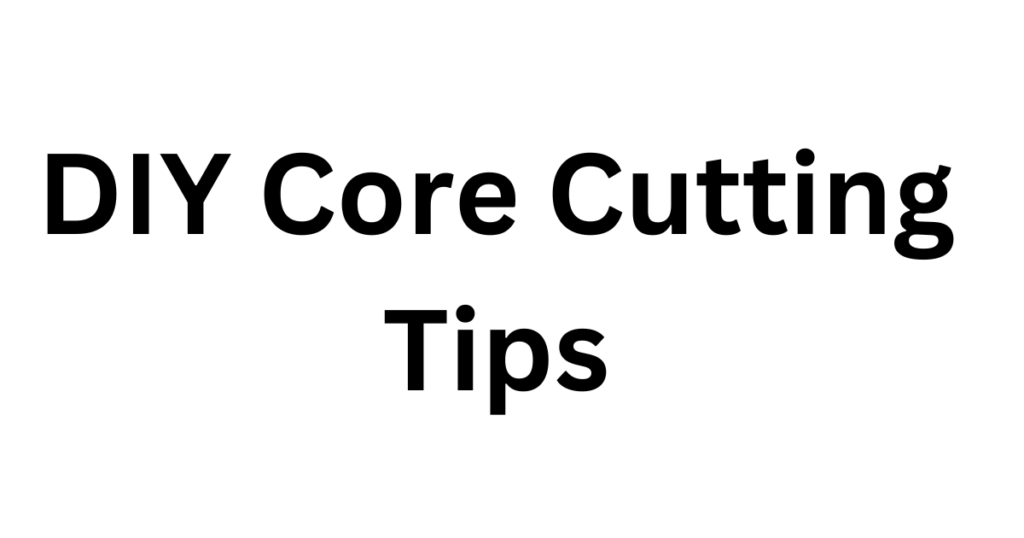Core cutting, also known as coring or hole drilling, is a common task in construction and DIY projects. Whether you need to create holes for plumbing, electrical work, or simply want to revamp your home, learning how to core cut can be a valuable skill. However, it’s crucial to approach this task with caution, as it involves power tools and can be potentially hazardous if not done correctly. In this guide, we’ll offer advice and step-by-step instructions for DIY core cutting projects, along with safety precautions to ensure your project is a success.
Safety First
Before diving into the core cutting process, it’s essential to prioritize safety. Here are some safety precautions to keep in mind:
- Protective Gear: Always wear appropriate safety gear, including safety glasses, hearing protection, a dust mask, and work gloves. These items will shield you from debris and noise.
- Proper Ventilation: Ensure you’re working in a well-ventilated area to minimize exposure to dust and fumes.
- Check for Utilities: Before drilling, locate and mark the positions of any electrical, plumbing, or gas lines in the area. You can use a stud finder or consult utility maps.
- Power Tool Familiarity: If you’re using power tools like a core drill, make sure you’re familiar with their operation. Read the user manual and follow safety guidelines.
- Steady Surface: Secure your workpiece on a stable surface to prevent slips or accidents.
- First Aid Kit: Have a basic first aid kit on hand in case of minor injuries.
Now that you’ve taken the necessary precautions, let’s proceed with the core cutting process.
Materials and Tools
To get started, gather the following materials and tools:
- Core drill machine: Choose the appropriate size for your hole diameter.
- Core bit: Select the right size and type of core bit (diamond-tipped for concrete, masonry, or stone).
- Water source: Core drilling generates heat, so you’ll need water for cooling and lubrication.
- Safety gear: As mentioned earlier, wear safety glasses, hearing protection, a dust mask, and work gloves.
- Marker: Use a marker to outline the hole’s position.
- Depth gauge: Measure the depth of your hole to ensure accuracy.
- Ruler or tape measure: Helpful for marking and measuring.
- Extension cord (if needed): Ensure you have a suitable extension cord for your power tool.
Step-by-Step Core Cutting
Follow these steps for a successful core cutting project:
- Mark the Hole: Use a marker to outline the hole’s position on the surface you want to cut. Double-check your measurements and ensure they align with your project’s requirements.
- Secure the Workpiece: If you’re drilling into a vertical surface, use clamps or brackets to secure the workpiece in place. Make sure it won’t move during drilling.
- Attach the Core Bit: Install the appropriate core bit on your core drill machine. Make sure it’s securely fastened.
- Add Lubrication: Connect your water source to the core drill and position it to deliver a steady stream of water to the drilling area. Lubrication is crucial to prevent overheating and extend the life of the core bit.
- Set the Depth: Adjust the depth gauge on your core drill to the desired hole depth. This ensures uniform and accurate drilling.
- Start Drilling: Turn on the core drill and begin drilling. Apply gentle, even pressure, and allow the core bit to do the work. Don’t force it.
- Maintain Steady Speed: Maintain a consistent drilling speed to prevent overheating and ensure a clean, precise hole.
- Monitor Progress: Periodically stop and check the hole’s progress. Remove any debris that may accumulate in the hole to prevent clogging.
- Complete the Hole: Continue drilling until you reach the desired depth. Be cautious as you approach the end to avoid damaging the core bit.
- Turn off the Drill: Once the hole is complete, turn off the core drill and allow it to come to a complete stop before removing the core bit.
- Clean Up: Disconnect the water source and clean up the work area. Dispose of any debris properly.
Conclusion
DIY core cutting can be a rewarding and cost-effective way to complete various projects around your home or workplace. However, safety should always be your top priority. By following the safety precautions and step-by-step instructions provided in this guide, you can confidently tackle core cutting projects while minimizing risks. Remember to take your time, stay focused, and seek professional help if you encounter any challenges beyond your expertise. With practice, you’ll become proficient at core cutting and open up a world of possibilities for your DIY endeavors.
